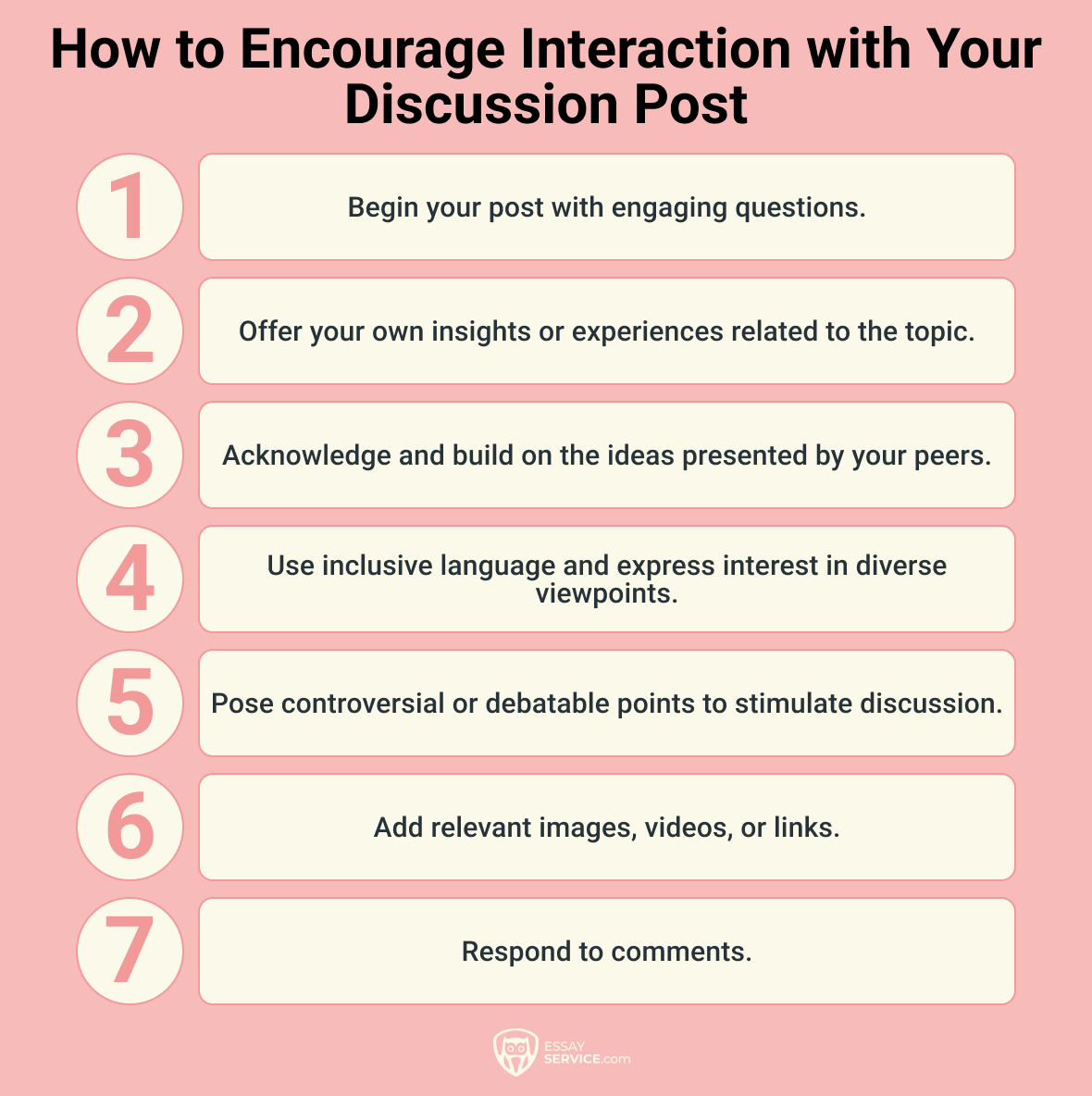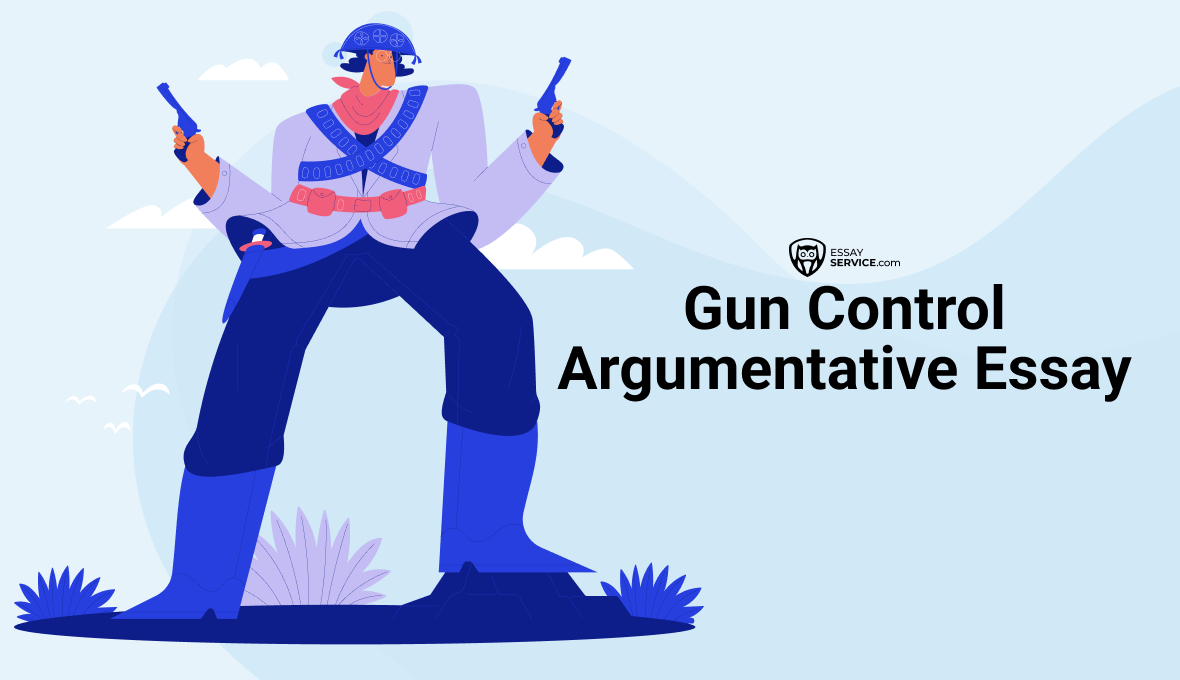.png)
How to Write a Discussion Post: A Guide to Effective Student Board Communication
Students often write debate posts in their academic coursework to foster critical thinking, collaborative learning, and a deeper understanding of course material. Firstly, writing a discussion post encourages active participation and interaction among students, promoting the exchange of diverse perspectives and ideas. Through articulating their thoughts and opinions in writing, students not only refine their communication skills but also develop the ability to construct well-reasoned arguments supported by evidence or relevant course content.
Moreover, writing posts cultivates a sense of ownership and responsibility for learning. Unlike traditional forms of assessment where students passively consume information, posts require them to take an active role in shaping the course discourse. By reflecting on assigned readings, synthesizing concepts, and engaging with peers in meaningful dialogue, students deepen their comprehension of the subject matter and take ownership of their learning process. This active involvement fosters a sense of accountability and motivation to participate actively in the academic community.
Furthermore, posts serve as a platform for honing critical thinking skills and fostering intellectual curiosity. By grappling with complex topics, analyzing different viewpoints, and respectfully challenging each other's ideas, students learn to think critically and approach issues from multiple perspectives. Additionally, the process of composing well-structured posts encourages students to organize their thoughts coherently, evaluate the validity of arguments, and constructively critique the ideas of their peers. Every expert essay writer is skilled in drawing up attention-grabbing board posts.

What Is a Discussion Post?
A discussion post meaning is a written communication typically conducted in an online learning environment or forum where individuals express their thoughts, ideas, or opinions on a specific topic. These posts serve as a platform for interactive and collaborative learning, allowing participants to engage in a structured conversation about the subject matter. Student posts are commonly used in educational settings, ranging from K-12 to higher education, to encourage students to articulate their viewpoints, respond to prompts, and engage in thoughtful exchanges with their peers. Most of the time, the APA citation style is used for writing debate posts.
In a debate post, participants often draw from assigned readings, course materials, or personal experiences to support their arguments or contribute to the overall discourse. The format may vary, but debate posts generally involve written responses that are visible to the entire group, fostering a community of learners. The goal is to create an environment where individuals can share diverse perspectives, ask questions, and challenge each other's ideas in a constructive manner. Through the exchange of written communication, posts promote critical thinking, active participation, and a deeper understanding of the subject matter within a collaborative learning community.
.png)
How Long Should a Discussion Post Be?
The ideal length for a discussion board post varies depending on the specific guidelines provided by the instructor or the platform. However, a general recommendation for how long should a discussion board post be is often to aim for a post that is substantive and meaningful, typically consisting of a minimum of 150 to 250 words. This length helps express well-developed thoughts and ideas, ensuring that the post contributes meaningfully to the ongoing discussion.
While conciseness is valued, participants must provide enough detail, context, and supporting evidence to convey their perspectives and engage fellow learners effectively. Adhering to any specified word count or guidelines set by the instructor helps maintain a balance between the depth of content and facilitating a dynamic and interactive discussion among participants.
What Makes a Good Discussion Post?
To write a successful discussion post students should follow several key principles. Firstly, thoroughly engage with the assigned material or prompt, demonstrating a clear understanding of the topic. Begin by crafting a concise and focused thesis statement or main point to guide your post. Support your arguments with relevant evidence, such as references to course readings, real-world examples, or personal experiences, to strengthen the validity of your perspective. Additionally, be mindful of the tone and language used, ensuring clarity and professionalism in your communication.
Moreover, successful debate posts actively engage with the contributions of peers. Respond thoughtfully to others' posts, providing constructive feedback or asking clarifying questions to foster a collaborative learning environment. Encourage dialogue by acknowledging diverse viewpoints and respectfully challenging ideas when necessary. Effective communication involves being concise and to the point while still conveying a depth of understanding. Here are several useful tips for you to follow:
- Ensure a comprehensive grasp of the topic before contributing to the discussion.
- Articulate a concise and focused main point to guide your post.
- Strengthen your arguments by incorporating relevant evidence from course materials or real-world examples.
- Maintain a respectful and professional tone in your writing to foster a positive discussion environment.
- Actively participate by responding thoughtfully to peers, providing feedback, and acknowledging diverse perspectives.
- Strive for concise writing while still conveying depth of understanding on the topic.
- Follow any provided guidelines on post length, formatting, and references to meet expectations and demonstrate attention to detail.
Always proofread your post to eliminate grammatical errors and enhance clarity. By embracing these practices, students can contribute meaningfully to discussions, showcase critical thinking skills, and ultimately foster a vibrant and enriching learning community.
APA Format Discussion Post Writing Hints
Writing an APA format discussion board post follows similar guidelines to general APA formatting for academic writing, with some adaptations for the informal nature of online discussions. Here's a step-by-step guide on how to write a discussion post in APA format:
Start with a Proper Heading
- Include your name.
- Mention the course title.
- Indicate the date.
- Example:
- John Doe
- PSY 101: Introduction to Psychology
- February 28, 2024
Write a Clear Introduction
- Begin with a concise introduction that outlines the topic you're addressing.
- Include a thesis statement or main point.
Body of the Discussion Post
- Organize your post into paragraphs for clarity.
- Use in-text citations if you refer to specific sources or ideas from your course materials.
- Example: (Author, Year).
- Keep the tone professional but conversational.
In-Text Citations
- If you refer to specific concepts, theories, or quotes, use in-text citations.
- Provide the author's last name and the publication year.
- Example: (Smith, 2019)
Reference List (if required)
- If you directly quote or paraphrase content from external sources, provide a reference list at the end.
- Follow the APA format for a discussion post regarding the reference list.
- Example: Smith, J. (2019). Title of the Book. Publisher.
Be Concise and Direct
- Keep your post concise while ensuring you address the main points.
- Aim for clarity in your expression.
Conclusion
- Conclude your post by summarizing your main points or posing questions to encourage further discussion.
Remember, specific course requirements may vary, so always check with your instructor for any additional guidelines or preferences they may have regarding discussion posts in APA format.
How to Write a Good Discussion Post in 4 Easy Steps?
Commencing a debate post with impact is crucial to capturing your audience's attention. Begin by crafting an opening that sparks curiosity or presents a thought-provoking question related to the topic. The best way to start a discussion post is by using an anecdote, a relevant quote, or a surprising fact to draw in your readers. The goal is to create an initial hook that not only introduces the subject matter but also compels your peers to continue reading with genuine interest.
Following the intriguing introduction discussion post writers should clearly state their main point or thesis. This serves as the compass for your post, providing direction and purpose. The thesis should be concise, offering a snapshot of your stance on the topic or the central theme you aim to explore. This upfront clarity not only guides your readers but also sets the stage for a focused and purposeful discussion.
Another effective technique for starting a debate post is to connect your topic to real-world relevance or current events. Highlighting the contemporary significance of the subject matter can create immediacy and relevance, making your post more engaging for your peers. It also demonstrates an understanding of the practical applications of the discussed academic concepts, which is a pretty similar experience to when you buy essay tasks from online experts.
In addition to these strategies for how to start a discussion post, consider inviting participation from your peers in your opening. Pose a question that prompts reflection or encourages others to share their perspectives. This not only fosters a sense of community but also sets the tone for an interactive and collaborative discussion. Ultimately, a strong start to your debate post lays the foundation for a compelling and enriching exchange of ideas within the academic community.

Step 1: Understanding the Topic
Begin by immersing yourself in the intricacies of the discussion prompt. The best way to respond to a discussion post is by reading any provided materials first, researching relevant sources, and grasping the nuances of the subject matter. Consider the historical context, contemporary relevance, and any potential controversies associated with the topic. The goal is to develop a comprehensive understanding of the APA citation discussion board post that goes beyond surface-level knowledge, enabling you to contribute thoughtfully to the discussion.
Step 2: Critical Thinking and Analysis
Take a stance on the topic and support it with well-reasoned arguments. Explore the underlying assumptions, biases, or implications associated with your perspective. Delve into the complexities of the issue, acknowledging its multifaceted nature. Employ critical thinking to anticipate counterarguments and address potential weaknesses in your position. By demonstrating a depth of analysis, you not only showcase your intellectual rigor but also contribute substantively to the ongoing conversation.
Step 3: Clarity and Coherence
Knowing how to write a discussion board post is all about communicating your ideas with precision and clarity. Use language that is accessible to your audience, avoiding unnecessary jargon. Structure your post logically, with a clear introduction, body, and conclusion. Connect your ideas coherently, utilizing transitions to guide the reader through your thought process. Employ vivid examples or analogies to illustrate your points, enhancing both understanding and engagement. A well-articulated post not only conveys your perspective effectively but also elevates the overall quality of the discussion. How to end a discussion post? Stay focused on the discussion prompt, providing concise and well-supported points. Foster a respectful and engaging environment by actively responding to others' contributions. It’s very similar to writing a persuasive essay, which is explained in detail in our other article.
Step 4: Encouraging Interaction
Transform your APA style discussion post into a catalyst for further exploration. Pose thought-provoking questions that extend beyond the immediate topic, prompting your peers to reflect on broader implications or share personal experiences. Acknowledge and respond to other participants' contributions, fostering a sense of collaboration. By actively seeking input and encouraging diverse viewpoints, you contribute to a vibrant and inclusive discussion environment, enriching the learning experience for everyone involved.
APA Format Discussion Board Post Example
In this section, we’ve prepared a couple of discussion post examples for your inspiration. You can check them out to see how to cope with such an assignment hands-on. But first, let’s start with how to start a discussion post examples:
- Provocative Question: "How do cultural influences shape our definition of success? Can we identify universal markers of achievement, or is success inherently subjective?"
- Personal Anecdote: "Recently, I faced a dilemma challenging societal norms. Confronting this, I wondered: How often do personal experiences clash with widely accepted beliefs? Has anyone else encountered such a situation?"
- Quoting a Relevant Source: "In her groundbreaking book 'Mindset,' psychologist Carol S. Dweck argues that our beliefs about learning impact success. How might her insights apply to our ongoing discussions on education and achievement?"
- Current Event Tie-In: "Given the recent climate summit, let's discuss its implications for our ongoing conversation about sustainable practices. How do global events influence our perspectives on environmental issues?"
- Pose a Hypothetical Scenario: "Imagine a society where everyone defined success based on personal fulfillment rather than external validation. How would our discussions on achievement change in such a hypothetical scenario?"
APA discussion post example for the following prompt: “What are the advantages and disadvantages of online learning?”
Pros and Cons of Online Learning
So, online learning – good or bad? Well, the cool thing is it's super flexible. You can check out your lessons whenever, wherever, making it a real game-changer, especially for folks juggling work or family stuff (Smith, 2020).
But here's the catch. It's not all rainbows and sunshine. Miss the classroom banter? Yeah, online learning might leave you hanging. There's something about face-to-face chats and teamwork that's hard to replicate on a screen (Jones & Brown, 2019).
In a nutshell, online learning has its perks with the whole flexibility thing, but it's not the same as kicking it in a classroom. Finding the right balance is key as we ride the wave of this ever-changing education scene.
How to Write a Discussion Post Example?
When you have to produce an effective discussion post response example, it's crucial to consider the nuances of engaging with peers.
- Pay attention to your peers' contributions, demonstrating genuine interest and understanding their perspectives before responding.
- Maintain a respectful and positive tone in your interactions, fostering a constructive atmosphere conducive to open dialogue.
- Provide feedback that is constructive and specific, focusing on the content of their ideas rather than personal attributes.
- Acknowledge and build upon your peers' ideas to contribute to the depth and breadth of the discussion, creating a collaborative environment.
- Welcome and appreciate diverse viewpoints, recognizing that varied opinions contribute to a richer and more comprehensive understanding of the topic.
Formulating a response to a discussion post examples from various perspectives can be enlightening. For instance, a response to a debate post example could involve acknowledging and building upon a classmate's insights, fostering a dynamic exchange of ideas. That’s why we offer you to analyze our discussion board post examples to enhance your understanding of not only the topic but also the collaborative nature of online discourse. To achieve that goal, we’ll be answering the following prompt: “In your opinion, what is the future of education?”
What's Next for Education? My Take.
So, where's education headed? Here's my two cents. I reckon tech's gonna be huge. Think online classes, interactive apps – the whole shebang. But, not everyone's got the same access, so we gotta make sure everyone's on board, ya know?
Also, we gotta shake things up in the classroom. No more one-size-fits-all. Let's tailor learning to each student, letting them chase their passions. That way, we're not just prepping 'em for tests; we're prepping 'em for life.
So, what's your take on the future of education? Let's chat!
Final Word
Discussion board posts can significantly enhance student education by fostering active engagement, critical thinking, and collaborative learning. Through the process of articulating their ideas, students deepen their understanding of course material as they grapple with complex concepts and apply them to real-world scenarios. Furthermore, engaging in discussions with peers exposes students to diverse perspectives and encourages them to consider alternative viewpoints, broadening their perspectives and promoting empathy. By participating in discussion board activities, students develop essential communication skills, including articulating their thoughts clearly and respectfully, which are invaluable in both academic and professional settings. If you need help with this assignment, simply say, ‘write my discussion post,’ and our writers will handle it.
Frequently asked questions
How to Post on Blackboard Discussion Board?
To post on the Blackboard Discussion Board, browse the designated discussion forum within your course. Locate the "Create Thread" or similar button, which allows you to initiate a new debate post. Craft your message, incorporating any required content, and utilize the formatting tools provided by Blackboard to enhance clarity. Once satisfied with your post, hit the "Submit" or "Post" button to share your contribution with your peers. Always review any specific guidelines or instructions from your instructor regarding the discussion format or additional requirements.
How to Respond to a Discussion Post?
When responding to a debate post, thoroughly read the initial post to grasp the author's main points. Click on the "Reply" or equivalent button to access the response interface. Craft your reply, ensuring it directly addresses the content of the original post. Consider building on their ideas, asking questions for clarification, or respectfully offering alternative perspectives. Utilize proper etiquette, maintaining a positive and constructive tone throughout your response. Finally, review your reply before submitting it to catch any errors or ensure clarity in your communication.
How to Write a Discussion Post for College?
When writing a debate post for college, start by thoroughly understanding the prompt or topic. Conduct any necessary research to inform your response. Structure your post with a clear introduction, body, and conclusion, ensuring each paragraph contributes to your overall argument or perspective. Support your ideas with evidence, examples, or references to course materials. Engage critically with the topic, showcasing thoughtful analysis and considering different viewpoints. Additionally, adhere to any specific formatting or citation guidelines provided by your instructor. Finally, proofread your post to eliminate errors and enhance the professionalism of your contribution.
New posts to your inbox!
Your submission has been received!



